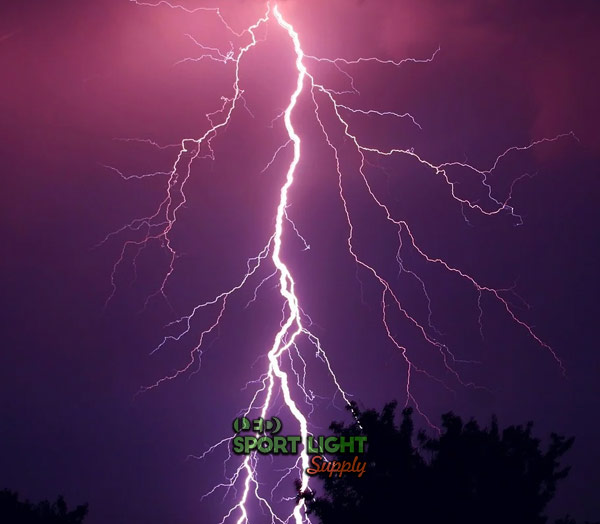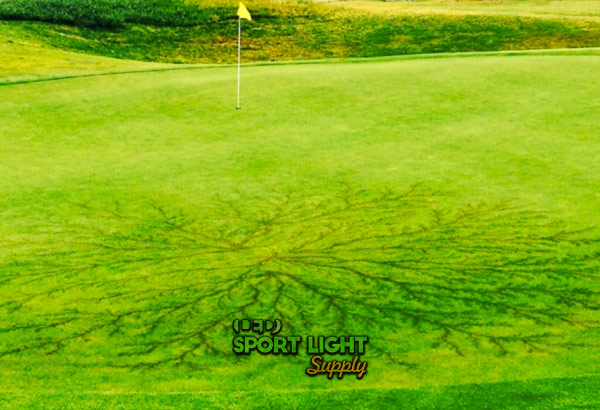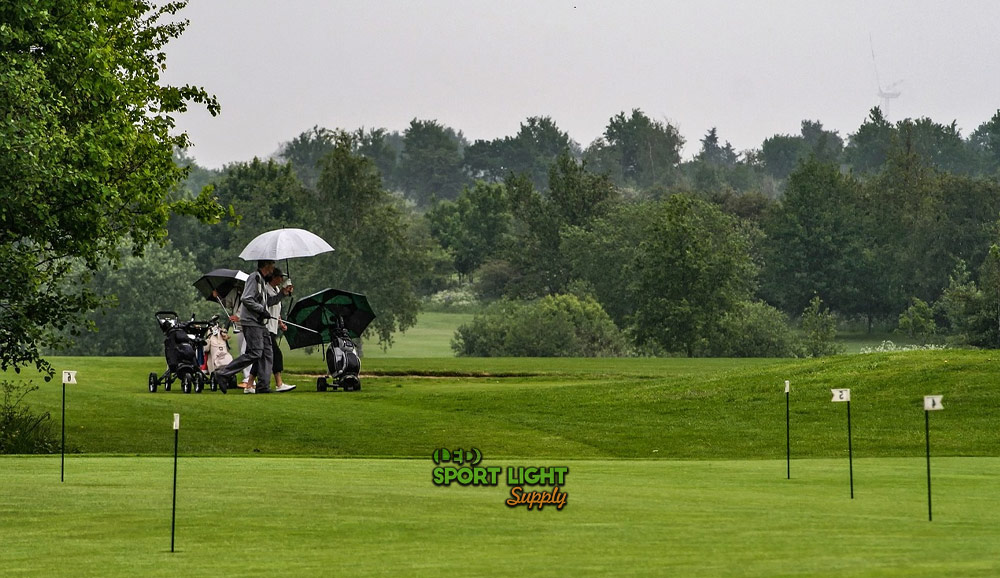Golfing may not immediately come to mind as a dangerous sport, but adverse weather conditions can quickly change that perception. Lightning, in particular, is a serious hazard as storms can develop rapidly, posing significant risks. This safety guide provides valuable insights into the risks associated with lightning and offers practical advice on how to safeguard yourself. Additionally, it covers the official golf course rules and policies regarding lightning. Following these guidelines could prove crucial for your safety.
Table of Contents
ToggleWhy is Lightning Dangerous on a Golf Course?

The Unpredictability of Storms
Weather conditions play a crucial role in outdoor safety, and this is particularly true on a golf course. Storms can develop unexpectedly when weather fronts collide and combine, creating unpredictable conditions. Even on days that start out sunny and calm, thunderstorms can appear suddenly. This unpredictability makes golfing especially hazardous, as you are often exposed in an open area with limited options for finding safe cover.
The Risks of Golf Equipment
Golf clubs, particularly putters and wedges, can act as lightning rods due to their metal composition. This increases the risk of lightning strikes since the clubs can attract electrical discharges. One lesser-known fact is that lightning can strike up to 10 miles away from an approaching storm. Additionally, lightning strikes can occur even after a storm has passed. In fact, over half of all lightning-related fatalities on golf courses happen after the thunderstorm has moved through.

The Hazards of Being the Tallest Object
Golfers are often the tallest objects on the course, making them prime targets for lightning strikes. Lightning typically travels from clouds to the ground due to electrical build-ups, but it can also move horizontally from cloud to cloud. In rare cases, it may travel over 2-3 miles horizontally before reaching its target. This unpredictability makes lightning particularly dangerous for golfers.
Statistics on Lightning Strikes and Golfers
Lightning-Related Fatalities
According to a survey conducted by the National Lightning Safety Council from 2006 to 2019, more than 29% of lightning-related fatalities occurred while golfing. In total, over 418 lightning-related deaths were reported in the US over this 14-year period. Surprisingly, fishing has been identified as the most dangerous outdoor sport, with golf closely following.

Trends in Fatalities
On average, 27 golfers are killed each year in the US due to lightning strikes. The demographic of those affected has shifted; the average age of fatalities is now between 20 and 29 years old, compared to the previous decade’s average of 29 to 39 years old. This younger demographic may be less aware of weather changes and the dangers associated with lightning.
Seasonal Patterns
Lightning-related accidents occur most frequently during June and July, with these months showing the highest number of incidents. August and September also see a significant number of accidents, with May being another high-risk month. Most incidents tend to occur in areas near the Gulf Coast in the US, where weather changes can impact the Midwest more frequently.
Can You Play Golf While There is Lightning? Is it Safe?
Early Warning Systems and Lightning Protection
Golf courses equipped with early warning detection systems are relatively rare due to their high cost, and they are typically found at high-end courses that host major tournaments. Many smaller commercial golf courses use a lightning protection system, which may sound impressive but is often just a custom-built shelter. These shelters are designed to collect and safely ground lightning strikes with a roof and grounding system.
These shelters provide a high level of safety as they are well-insulated and equipped with lightning rods and grounding systems that direct electrical currents safely into the ground. Those inside the shelter are protected from lightning strikes. After a storm has passed, golfers should return to the clubhouse for additional protection.
Recommendations for Playing Golf During Lightning
While it is not advisable to play golf during a lightning storm, there are guidelines to follow for safety. The general recommendation is to wait at least 30 minutes after the last lightning strike before resuming play. This waiting period allows any residual static electricity in the clouds to dissipate, reducing the risk of additional lightning strikes.
What Are the USGA Golf Course Lightning Policies and Rules?
Estimating the Distance of a Storm
The USGA provides some guidance on how to assess lightning safety on the golf course. One practical method is to estimate the distance of an approaching storm by counting the time between seeing lightning and hearing thunder. Since sound travels slower than light, a 10-second delay between the lightning flash and the thunder indicates that the storm is approximately two miles away.
Following the 30/30 Rule
The 30/30 rule is a commonly used safety guideline. If you see lightning and then hear thunder within 30 seconds, you should wait 30 minutes before resuming golf activities. However, this rule may be less effective if there are multiple storms or if you have not heard an official warning from the golf course.
Avoiding Tall Objects
A common myth suggests that avoiding tall trees is sufficient protection, but in reality, any tall standing object can attract lightning. The best course of action is to seek shelter in a lightning-safe structure. If the clubhouse is accessible and safe, it is preferable to wait there until the storm passes.
Debunking the Myth of Lightning Never Striking Twice
It is a persistent myth that lightning never strikes the same spot twice, but this is not true. Lightning can strike the same location multiple times, especially under certain conditions. Therefore, it is unwise to seek shelter in an area that has been struck previously. This precaution is essential for preventing further accidents and ensuring golfer safety.
What to Do on a Golf Course During a Thunderstorm
Seek Shelter
If you find yourself caught in a thunderstorm on a golf course and cannot make it to the clubhouse, your priority should be to find any available shelter. If there is a lightning-protected hut on the course, it is the safest place to wait until the storm passes. Avoid using covered golf carts as they offer minimal protection and can pose an electrocution hazard if struck. Additionally, do not seek shelter next to concrete walls or overhangs, as these can also attract lightning.
Follow the Siren Rules
Golf courses often use a system of horn blasts to signal when play should stop due to a storm. A single long blast of the air horn typically indicates that play should cease immediately. In the event of an imminent lightning storm, the standard signal is three short blasts of the siren. Most golf courses follow this siren rule to provide timely warnings. Be alert to these signals and take immediate action to seek safety.

Avoid Standing Under Trees
Trees are known to attract lightning because of their height, making it extremely dangerous to stand underneath them during a storm. If caught in a lightning storm, maintain a safe distance from trees and seek refuge in a stable structure if possible. On a golf course, look for any available structures spaced between the holes that can provide temporary shelter from the storm.
Steer Clear of Water Puddles
Water is a conductor of electricity, so standing in or near water puddles during a lightning storm can be hazardous. If lightning strikes close to a puddle you are standing in, the electrical current can travel through the water and cause injury. Try to find a dry area to avoid the risk of electrical shock, especially if rain has left puddles on the course.
Avoid Using an Umbrella
Umbrellas, often made of metal, can conduct electricity if struck by lightning. Using an umbrella during a lightning storm significantly increases your risk of being struck. Even if you get wet, it is safer to avoid using an umbrella and seek shelter in a safe location instead. An umbrella acts as a lightning rod and should not be used during a thunderstorm.
Golf Course Lightning FAQ
Are Golf Carts Safe from Lightning?
Driving a golf cart during a lightning storm is highly unsafe. Golf carts offer no insulation against lightning strikes and are more vulnerable due to their limited speed and traction, especially on wet surfaces. Rain can make the course slippery, increasing the risk of the cart skidding or crashing. Therefore, it’s crucial to seek proper shelter rather than relying on a golf cart for protection during a storm.
What is the Meaning of the Golf Course Lightning Siren?
Golf courses use a system of horn blasts to signal when players should stop their round due to imminent danger. A long blast of the siren typically indicates that players should prepare to end their round. In the case of an immediate threat, such as a lightning storm, three short blasts serve as a warning to cease play immediately. This system helps ensure players have enough time to seek safety.
How Can You Tell How Close a Storm Is on a Golf Course?
To estimate the distance of a thunderstorm, you can use the lightning and thunder method. Count the number of seconds between seeing a lightning flash and hearing the thunder. Since sound travels approximately 2 miles in 10 seconds, this method helps gauge how far away the storm is. For example, a 10-second interval indicates the storm is about 2 miles away.
How Often Do Golfers Get Hit by Lightning?
Lightning strikes on golf courses are a significant safety concern, with fatalities rising in the US each year. Certain months, particularly those with frequent thunderstorms, pose a higher risk for golfers. In areas like the Midwest, where storms are unpredictable, golf courses should have dedicated shelters and sound the three-siren warning to give golfers time to seek safety.
Is it Safe to Play Golf in Lightning Conditions?
According to golf rules, players have the option to continue or discontinue play based on their assessment of the risk. Golf courses often have waivers to limit their liability in case of accidents related to lightning. However, it is essential for golf courses to provide designated safety zones and enforce safety protocols. Players should prioritize their safety and seek shelter rather than risk playing during a lightning storm.
Our Conclusion
Golf course safety should not be taken lightly, especially during thunderstorms. In the event of lightning, seek shelter immediately, and familiarize yourself with the locations of lightning safety areas on the course. These shelters could be crucial for your safety during a storm and should be utilized to protect yourself from lightning hazards.
